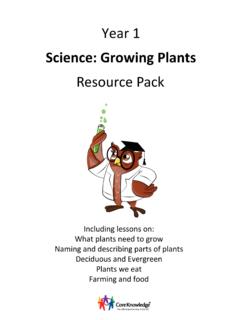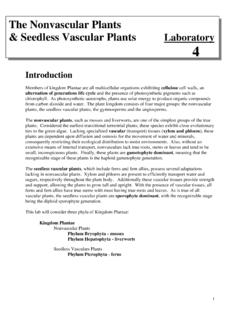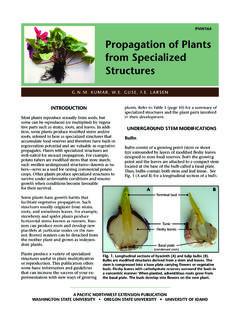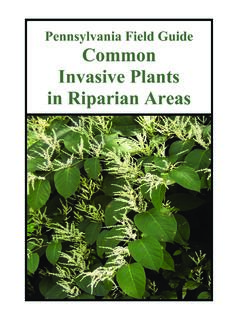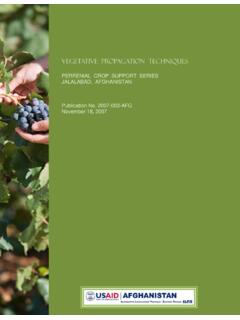Transcription of Parts of the Seed - MyCAERT
1 Parts of the seed O F ALL the facets of nature, the plant seed must be one of the most wondrous. When a plant creates new life through sexual reproduction, it encases the new life in a tiny protective package, along with a supply of food. This is the seed . Objective: Identify the Parts of a seed . Key Terms: cotyledon dicotyledon embryo endosperm epicotyl hilum hypocotyl micropyle monocotyledon plumule radicle seed coat suspensor E-unit: Parts of the seed u Page 1 u Copyright 2006 by CAERT, Inc. Reproduction by subscription only.
2 070026. seed Parts The seeds for new life are found inside fruit. They contain everything necessary for the growth and development of a new plant. The three primary Parts of a seed are the embryo, endosperm, and seed coat. The embryo is the young multicellular organism before it emerges from the seed . The endosperm is a source of stored food, consisting primarily of starches. The seed coat consists of one or more protective layers that encase the seed . seed coat Epicotyl Endosperm Hypocotyl Cotyledons Epicotyl Cotyledon seed coat Radicle Dicotyledon Monocotyledon FIGURE 1.
3 The seeds of monocotyledons differ from the seeds of dicotyledons. A seed begins to form an embryo following fertilization and the start of a zygote. The initial division of the zygote results in two cells. The bottom cell develops into a multicellular struc- ture, called the suspensor. It is involved in nutrient uptake from the endosperm and anchors the embryo. The top cell develops into the embryo. The first cell divisions from this top cell create a chain of cells called the proembryo. As the cell divisions continue, a globular embryo takes shape.
4 At this point of development, cells begin to differentiate. Cotyledons begin to form in the shape a heart, in the case of dicotyledon plants. This stage of development is aptly named the heart stage. The cotyledons grow and elongate in the torpedo stage. As the embryo matures, the pressure of the expanding embryo crushes the suspensor. The mature embryo consists of an embryonic root known as the radicle, an embryonic shoot, and one or two cotyledons. The embryonic shoot, known as the plumule, has two main Parts , the epicotyl and the hypocotyl.
5 The epicotyl is the portion of the embryonic stem above the point at which the stem is attached to the cotyledon(s). The hypocotyl is the por- tion below the point of attachment. The hypocotyl is connected to the radicle. The cotyledon is described as a seed leaf that stores food in the form of starch and protein for use by the embryo. An embryo of a monocotyledon (monocot) plant has one cotyledon, while that of a dicotyledon (dicot) plant has two cotyledons. A monocot stores the bulk of its energy in the endosperm.
6 A dicot stores its food in the two cotyledons. E-unit: Parts of the seed u Page 2 u Copyright 2006 by CAERT, Inc. Reproduction by subscription only. 070026. Zygote Embryo Suspensor Zygote Cotyledon seed coats Endosperm Suspensor Proembryo Torpedo stage Heart stage Globular embryo FIGURE 2. Embryonic development of a dicotyledon. The seed is encased in a protective seed coat. It protects the embryo and the endosperm from drying and from physical injury. A scar can be seen at the end or along the side of the seed coat.
7 It is called the hilum. The hilum marks the point of attachment of the seed to the ovary wall. The seed coat has a tiny opening, sometimes visible near the hilum, called the micropyle. Summary: 2 Seeds contain everything necessary for the growth and development of a new plant. The three primary Parts of a seed are the embryo, endosperm, and seed coat. The embryo is the young multicellular organism before it emerges from the seed . The endosperm is a source of stored food, consisting primarily of starches. The seed coat consists of one or more protective layers that encase the seed .
8 The mature embryo consists of an embryonic root known as the radicle, an embryonic shoot, or plumule, and one or two cotyledons. The cotyledon is described as a seed leaf that E-unit: Parts of the seed u Page 3 u Copyright 2006 by CAERT, Inc. Reproduction by subscription only. 070026. stores food in the form of starch and protein for use by the embryo. An embryo of a monocotyledon (monocot) plant has one cotyledon, while that of a dicotyledon (dicot) plant has two cotyledons. Checking Your Knowledge: 1. Name the three primary Parts of a seed and define each.
9 2. What is the purpose of the seed coat? 3. What is a cotyledon? Expanding Your Knowledge: L Without looking at Figure 1, label the Parts of the seeds of a monocotyledon and a dicotyledon on this drawing. Then, check your answers against Figure 1. _____ _____. Web Links: : Arizona Master Gardener Parts of a seed Wikipedia E-unit: Parts of the seed u Page 4 u Copyright 2006 by CAERT, Inc. Reproduction by subscription only. 070026.

